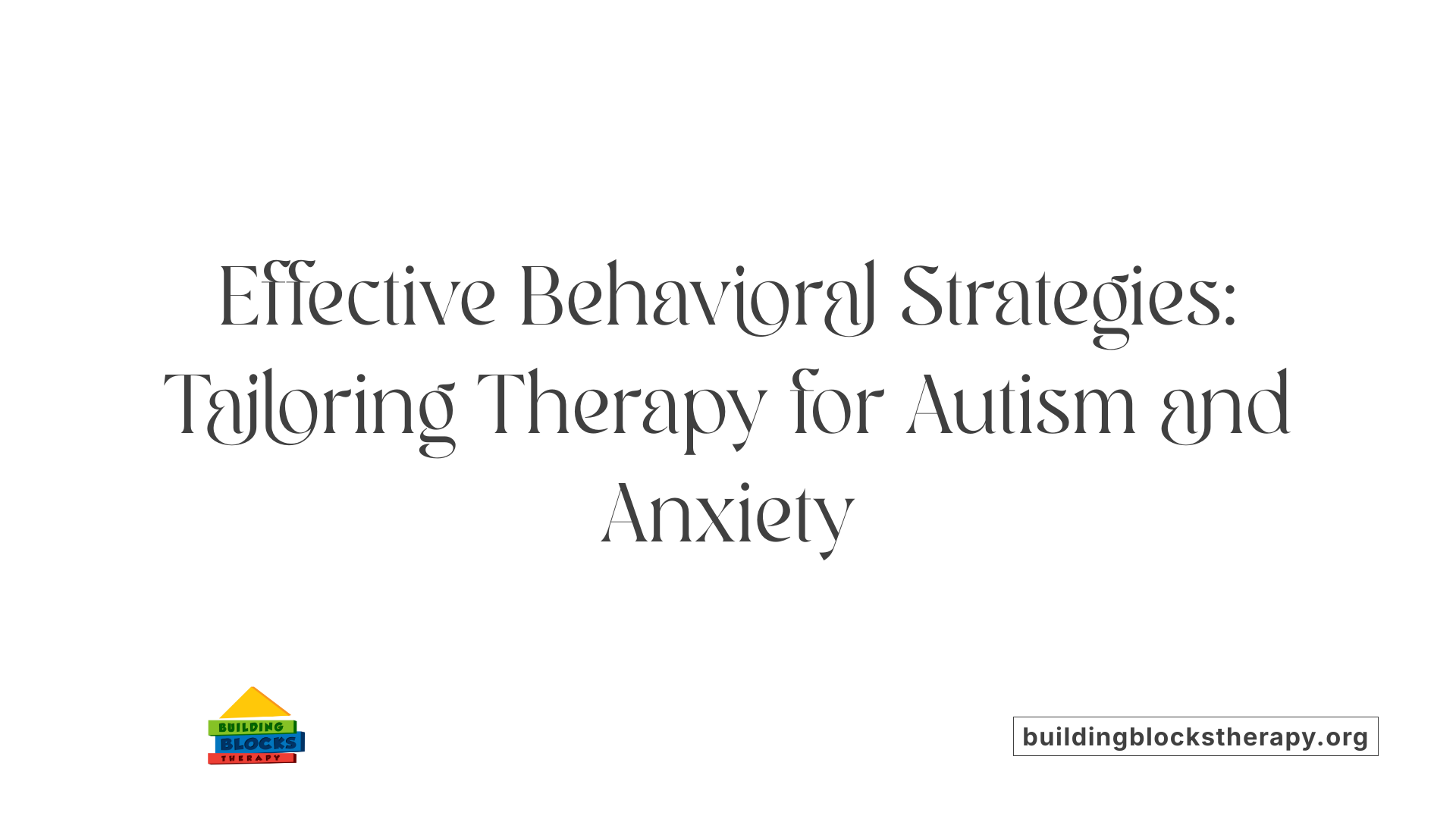The Role of Therapy in Addressing Anxiety in Children with Autism
Transforming Anxiety Treatment in Autism: Evidence-Based Therapy Approaches

Understanding the Critical Role of Therapy in Autism-Related Anxiety
Anxiety is a prevalent and often debilitating challenge faced by children with autism spectrum disorder (ASD). Addressing this issue requires a nuanced understanding of effective therapeutic approaches that can alleviate symptoms and improve overall well-being. This article explores how tailored therapies, particularly cognitive-behavioral therapy (CBT) and applied behavior analysis (ABA), serve as foundational interventions. We will examine the evidence supporting these approaches, adaptations for individual needs, and the essential involvement of parents and caregivers in maximizing treatment success.
Efficacy of Adapted Cognitive-Behavioral Therapy (CBT) for Autism-Related Anxiety

How effective is cognitive-behavioral therapy (CBT) for children with autism who experience anxiety?
Research consistently shows that CBT, especially when adapted for children with autism spectrum disorder (ASD), is helpful in reducing anxiety symptoms. Multiple controlled studies and reviews demonstrate significant improvements in anxiety levels rated by parents and clinicians, often with large effect sizes initially. For example, meta-analyses involving around 469 children found overall large effects, with effect sizes close to 1.2.
However, child self-reports tend to show smaller improvements, highlighting some measurement challenges. Still, these findings support that adapted CBT can significantly alleviate anxiety symptoms, including fears, avoidance behaviors, and social challenges. Randomized clinical trials have emphasized the importance of tailoring treatment to the child's needs, incorporating visual aids, concrete steps, and involving parents actively.
Feasibility studies in community settings indicate that adapted CBT programs like 'Facing Your Fears' are manageable and well-received, with high satisfaction among families. These interventions not only reduce anxiety but also help children improve social and emotional skills.
While most studies focus on high-functioning children with ASD, baseline anxiety levels and overall functioning can influence individual responses. Despite some limitations such as methodological flaws and small samples, evidence suggests that adapted CBT remains a reliable and effective choice. Future research aims to compare CBT with other treatments and explore its effectiveness across diverse environments, including schools.
Overall, adapted CBT offers a promising approach to help children with autism manage anxiety efficiently, contributing to better emotional well-being and social functioning.
The Promise of Evidence-Based Practices: CBT and ABA as Cornerstones
There is a substantial body of research supporting the use of evidence-based practices to manage anxiety in children with autism. Systematic reviews and meta-analyses have consistently confirmed the effectiveness of cognitive-behavioral therapy (CBT), especially when tailored to meet the unique needs of autistic children. For instance, a comprehensive meta-analysis involving 469 participants revealed that CBT yields large effects in reducing anxiety symptoms, with effect sizes around d=1.19 to 1.21 based on parent and clinician ratings. Child self-reports also show positive results, although with slightly smaller effects.
Adapted CBT programs, which incorporate visual aids, concrete steps, gradual exposure, and parent involvement, have demonstrated significant success. Studies such as those by Cervin et al. (2023) highlight that therapy improvements include decreased anxiety intensity, reduced avoidance behaviors, and better social functioning.
Applied Behavior Analysis (ABA) also plays a vital role in managing anxiety behaviors. ABA strategies are individualized to each child's needs, helping them understand and cope with anxiety triggers. Techniques like breaking down tasks, using sensory tools, visual schedules, and involving families create a supportive environment that fosters emotional regulation and behavioral improvements.
Research-backed benefits of combining therapies, such as CBT with ABA or occupational therapy, are increasingly recognized. A multi-modal approach helps address both the emotional and behavioral aspects of anxiety.
| Evidence Type | Outcomes | Notable Studies | Impacts on Treatment |
|---|---|---|---|
| Meta-analysis | Large effect sizes d ~1.19–1.21 | Reaven et al. (2012), Cervin et al. (2023) | Significant reduction in anxiety symptoms |
| Systematic Reviews | Confirmed CBT efficacy | Weston et al. (2016), Perihan et al. (2022) | Improved social skills and adaptive behaviors |
| Clinical Trials | Adapted CBT benefits | Storch et al. (2013), James et al. (2020) | Reduced avoidance and increased participation |
Overall, these scientific findings establish a strong foundation for implementing CBT and ABA as primary treatment modalities. Future research continues to refine these approaches, aiming for even more personalized and effective interventions that improve both emotional well-being and daily functioning for children with autism.
Behavioral Strategies and Adaptations in Therapy

What strategies can be used to adapt therapy for children with autism experiencing anxiety?
Adapting therapy for children with autism who experience anxiety requires thoughtful modifications to standard approaches. Visual supports, such as picture schedules and social stories, are commonly used to help children understand what to expect, reducing uncertainty and stress. These tools are especially effective when integrated into Cognitive Behavioral Therapy (CBT), which emphasizes concrete and visual information, clear instructions, and structured routines.
Involving family members is crucial. Parents can learn strategies to reinforce coping skills at home and support generalization across various situations. Therapists often incorporate parent training into sessions, empowering caregivers to implement techniques like gradual exposure and emotional regulation strategies.
Sensory considerations also play a vital role. Using sensory-friendly interventions—such as weighted blankets, sensory breaks, or calming tools—can help children feel more comfortable and engaged during therapy sessions. Tailoring interventions to each child's interests and sensory profile fosters a supportive environment that promotes participation and resilience.
Behavioral approaches like Applied Behavior Analysis (ABA) can be personalized to identify specific anxiety triggers. ABA techniques focus on breaking down complex tasks into manageable steps and teaching coping mechanisms, enhancing a child's ability to navigate anxiety-provoking situations.
Training and supervision ensure that therapists implement these adaptations effectively. When combined, these strategies create a comprehensive, individualized framework that addresses the unique needs of children with autism facing anxiety, leading to more favorable therapeutic outcomes.
The Pivotal Role of Parental and Caregiver Involvement
 Parents and caregivers are central to the success of therapeutic interventions aimed at reducing anxiety in children with autism. Their active participation not only supports children during therapy sessions but also helps reinforce skills learned outside the clinical setting.
Parents and caregivers are central to the success of therapeutic interventions aimed at reducing anxiety in children with autism. Their active participation not only supports children during therapy sessions but also helps reinforce skills learned outside the clinical setting.
During therapy, parental involvement can include co-facilitating sessions, coaching children through coping strategies, and providing consistent emotional support. These actions facilitate the transfer of skills into everyday environments, such as school or home, encouraging children to manage anxiety more effectively.
Support and training for parents are vital components. Many programs offer guidance on how to implement therapeutic techniques like cognitive-behavioral strategies and mindfulness at home. This ongoing involvement enhances the child's ability to generalize and sustain progress, leading to better long-term outcomes.
Building the transfer of skills across various settings is facilitated by structured collaboration between parents and therapists. Tools such as visual schedules, social stories, and behavioral charts created with parent input help children understand what to expect and how to cope.
Research shows that when parents actively respond to their child's anxiety with understanding and consistent routines, there is a significant improvement in anxiety symptoms. Attitudes like responsiveness, patience, and positive reinforcement are crucial.
Programs tailored for parent participation, especially in adapted CBT and mindfulness interventions, have demonstrated notable reductions in both child and parent anxiety levels. This underscores the importance of involving caregivers in the therapy process—that their engagement can dramatically influence the effectiveness of treatment.
In sum, the role of parents and caregivers extends beyond supporting therapy sessions; they are vital partners in fostering resilience and emotional regulation in children with autism facing anxiety challenges.
Recognizing and Managing Anxiety Symptoms in Children with Autism
What are common signs of anxiety in children with autism?
Children with autism often display a variety of signs indicating anxiety. Physically, they might experience stomachaches, headaches, rapid heartbeat, muscle tension, sweating, and sleep difficulties. Behaviorally, signs include excessive worry, avoidance of certain situations, emotional outbursts, meltdowns, and increased repetitive behaviors such as hand-flapping or rocking.
External signs may involve physical actions like head-banging, scratching, shredding paper or clothing, or seeking sensory input to soothe themselves. These behaviors often reflect underlying anxiety rather than mere autism symptoms alone.
Internally, children may feel fear, an overwhelming sense of doom, restlessness, or have trouble focusing. These internal feelings can be confused with or masked by autism traits, making recognition more challenging.
Early identification of these signs is crucial. Using visual supports, establishing predictable routines, and employing relaxation techniques can help children with autism better manage their anxiety. Parents, caregivers, and therapists should be attentive to these signals to provide timely support and appropriate interventions.
Implementing Practical Strategies for Anxiety Management
What practical strategies can help children with autism manage anxiety?
Children with autism often face unique challenges when managing anxiety, but several practical approaches can make a significant difference. One of the most effective strategies is the use of visual supports, which include social stories, visual schedules, and pictorial aids. These tools help children understand upcoming events, routines, and changes, reducing uncertainty and providing a sense of predictability.
Relaxation techniques are also vital. Techniques such as deep breathing exercises, mindfulness practices, and the use of calming sensory tools like weighted blankets or sensory toys help children self-regulate during stressful moments. Teaching children how to recognize their emotional states and employing sensory-based calming strategies can prevent anxiety from escalating.
Moreover, the involvement of parents, caregivers, and professionals is crucial. Training in evidence-based methods like cognitive behavioral therapy (CBT) and applied behavior analysis (ABA) equips caregivers with skills to identify triggers, support coping mechanisms, and create safe environments. Consistent collaboration among families, teachers, and therapists ensures interventions are tailored and effective.
In summary, combining visual supports, sensory tools, relaxation techniques, and collaborative efforts forms a comprehensive approach that helps children with autism build resilience against anxiety and develop important emotional regulation skills.
Conclusion: The Path to Better Well-Being through Tailored Therapy
 Therapy plays a vital role in helping children with autism manage anxiety effectively. Research shows that evidence-based treatments like cognitive-behavioral therapy (CBT) and applied behavior analysis (ABA) are particularly beneficial.
Therapy plays a vital role in helping children with autism manage anxiety effectively. Research shows that evidence-based treatments like cognitive-behavioral therapy (CBT) and applied behavior analysis (ABA) are particularly beneficial.
Adapted versions of CBT, which include visual aids, parent involvement, and individualized strategies, have demonstrated a significant reduction in anxiety symptoms. These therapies not only target the worries and fears specific to each child but also improve their social skills and emotional regulation.
In sessions, therapists work with children to identify their fears, challenge negative thoughts, and practice calming techniques. Exposure exercises gradually help them confront anxiety-provoking situations, leading to lasting improvement.
ABA complements these efforts by breaking down complex behaviors, fostering new coping skills, and reinforcing positive changes across different settings. Family involvement and professional guidance are essential in sustaining these gains.
Overall, personalized, research-supported therapies empower children with autism to navigate their worlds with greater confidence and calmness, improving their quality of life.
For more information, searching “comprehensive therapy approaches for anxiety in autism” provides useful resources to explore tailored treatment options.
Supporting Children with Autism in Overcoming Anxiety Challenges
Therapeutic interventions tailored to the unique needs of children with autism are vital in effectively managing anxiety. Evidence-based approaches like adapted CBT and ABA provide the tools necessary to help children reduce anxiety symptoms, improve emotional regulation, and foster social development. The success of these therapies depends on individualized planning, incorporating sensory considerations, visual supports, and active parental involvement. As research continues to evolve, the combined efforts of mental health professionals, families, and educators will remain essential in creating supportive environments that empower children with autism to thrive beyond their anxieties.
References
- Cognitive Behavioral Treatments for Anxiety in Children With Autism ...
- Autism and Anxiety: Treatment Options and ABA Techniques
- Cognitive-Behavioral Therapy for Anxiety in Children With High ...
- Adapting cognitive behavioral therapy for anxiety in autistic children
- Managing anxiety in children with autism | Autism Speaks
- Optimising Anxiety Treatment for Autistic Children: a Narrative Review
- Occupational Therapy To Deal With Anxiety In Children With Autism
- A conceptual perspective on the role of cognitive behavioural ...
- Autism Therapy - The OCD & Anxiety Center
- Autism and Anxiety - Autism Research Institute






